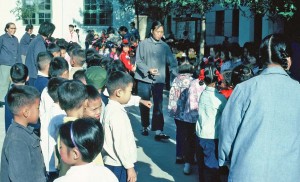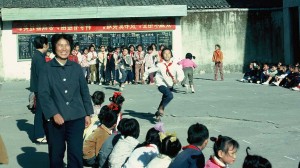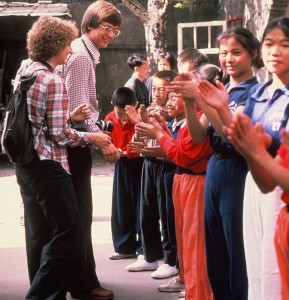Posts Tagged ‘The Arts’
Revisiting China – Part 1
![]() One of my projects as a result of our recent move is to sort and organize slides and pictures: one because of the need for the extra space, two to eliminate anything that still has smoke from our fire 20-plus years ago, and three to find a way to enjoy all these memories. Now that I have a home for “recycling” slide mounts and boxes, I am ready for this project. Slides are sorted into a slide box we had been given years ago and never used; there’s one drawer of China slides and a second drawer of personal slides. I’m starting on the China slides.
One of my projects as a result of our recent move is to sort and organize slides and pictures: one because of the need for the extra space, two to eliminate anything that still has smoke from our fire 20-plus years ago, and three to find a way to enjoy all these memories. Now that I have a home for “recycling” slide mounts and boxes, I am ready for this project. Slides are sorted into a slide box we had been given years ago and never used; there’s one drawer of China slides and a second drawer of personal slides. I’m starting on the China slides.
How to organize? One of the most impressive memories from this trip in 1978 (before normalization of relations with the US) was the visits to the schools, so that’s where I am starting. Some background: I was teaching middle school science at the time in Phoenix, Arizona, when I became involved with the US-China People’s Friendship Association, a group working to bring about normalization (the recognition of “Red China”) as a legitimate country. This has been a passion of mine for years, since early high school, and especially influenced by a book by William Lederer (senior moment – lost the name) about the “truth” about Chiang Kai-Shek. I won a number of debates in high school based on the strenghts of my pro arguments, which didn’t make me any more popular. Oh well, I WAS right.
In 1978 I was selected as one of 20 people from the western part of the United States to travel for 3 weeks in China. I had never been anywhere, and China was at the top of my travel list. I was in heaven! I was gone for nearly a month, have a full notebook of interviews and impressions, and probably well over a thousand slides (all of which are being weeded down to the best. Each place we visited (fron Guangchou – the “old” Canton” to Beijing) we were able to meet and ask questions. I was in charge of all the school stops, since I was the only teacher in the group. It was the most amazing adventure.
 Our first visit was an elementary school, and the playground looked suspiciously like the typical US school ground. Teachers were wandering around, organizing activities, like tug of war. Notice the blues and grays for colors, especially on the adults. We were there at the end of the Cultural Revolution; the Gang of Four had just been imprisoned. Bright colors were a “western” problem, and we had been asked in doing our packing to look at basic browns, blues, and grays for colors, pants, no dresses, to respect the Chinese. We only saw bright colors on the children, until we hit Tokyo on our way back – our senses were literally assaulted with color.
Our first visit was an elementary school, and the playground looked suspiciously like the typical US school ground. Teachers were wandering around, organizing activities, like tug of war. Notice the blues and grays for colors, especially on the adults. We were there at the end of the Cultural Revolution; the Gang of Four had just been imprisoned. Bright colors were a “western” problem, and we had been asked in doing our packing to look at basic browns, blues, and grays for colors, pants, no dresses, to respect the Chinese. We only saw bright colors on the children, until we hit Tokyo on our way back – our senses were literally assaulted with color.
 If you notice make-up on the children, it’s because many of them were going to be performing for us during our visit. We were treated to amazing displays of arts and athletics, and at the time China was not a player in sports on the world stage. We all know that has changed.
If you notice make-up on the children, it’s because many of them were going to be performing for us during our visit. We were treated to amazing displays of arts and athletics, and at the time China was not a player in sports on the world stage. We all know that has changed.
 I was particularly taken by the blackboard at the end of the playground, with all the announcements. It was pristine; no damage, vandalism, or the like. One of the questions I asked at our first meeting with the teachers and administrators of the school was how they dealt with vandalism. I ws asked to rephrase the question, and then asked to define vandalism. The teachers looked at each other, not understanding the word…or the concept. The reply was “why would anyone want to destroy what they need?” Why indeed….
I was particularly taken by the blackboard at the end of the playground, with all the announcements. It was pristine; no damage, vandalism, or the like. One of the questions I asked at our first meeting with the teachers and administrators of the school was how they dealt with vandalism. I ws asked to rephrase the question, and then asked to define vandalism. The teachers looked at each other, not understanding the word…or the concept. The reply was “why would anyone want to destroy what they need?” Why indeed….
 We saw all types of entertainment, from the little singers, singing songs of leading the good life according to Chairman Mao….
We saw all types of entertainment, from the little singers, singing songs of leading the good life according to Chairman Mao….
 …to guymnastic displays of all ages. Look carefully at their equipment. Floors covered with skinny rugs, bare walls – nothing like we would expect for building athletes.
…to guymnastic displays of all ages. Look carefully at their equipment. Floors covered with skinny rugs, bare walls – nothing like we would expect for building athletes.
 Some performances were more formal. This was a group of young ladies performing basic magic tricks for us, and they were very good. Stage presence was something I remarked upon at the time, and I still think it’s pretty amazing how poised they all were. I know how difficult it is to develop that in young children during theater.
Some performances were more formal. This was a group of young ladies performing basic magic tricks for us, and they were very good. Stage presence was something I remarked upon at the time, and I still think it’s pretty amazing how poised they all were. I know how difficult it is to develop that in young children during theater.
 This dance/song number talked about importance of water and work to develop a good cotton crop.
This dance/song number talked about importance of water and work to develop a good cotton crop.
 This is the classroom that sticks with me so many years later. Sixty students in the classroom, no textbooks in sight. If you look closely, you will see double-digit multiplication problems on the board. No paper visible among these second graders. Students would raise their hand with a solution they had worked out in their heads, be called upon, come to the front of the room, and respond. We don’t even begin teaching basic multiplication facts until third grade….
This is the classroom that sticks with me so many years later. Sixty students in the classroom, no textbooks in sight. If you look closely, you will see double-digit multiplication problems on the board. No paper visible among these second graders. Students would raise their hand with a solution they had worked out in their heads, be called upon, come to the front of the room, and respond. We don’t even begin teaching basic multiplication facts until third grade….
 We had certificates made up of our trip before we left the United States. We brought along a Polaroid camera to take pictures of our hosts and the group, which would then be affixed to the certificate. This is still one of my prized possessions. (I’m second row on the left….)
We had certificates made up of our trip before we left the United States. We brought along a Polaroid camera to take pictures of our hosts and the group, which would then be affixed to the certificate. This is still one of my prized possessions. (I’m second row on the left….)
 The children crowded around us to watch the picture develop – absolute magic!
The children crowded around us to watch the picture develop – absolute magic!
 Shanghai, as well as most other cities, had what were called Children’s Palaces, a place for students to go after school for more activities. A good many of them were focused on the arts, but many others were practical. Here’s one of our group members playing – of all things – Chinese jump rope.
Shanghai, as well as most other cities, had what were called Children’s Palaces, a place for students to go after school for more activities. A good many of them were focused on the arts, but many others were practical. Here’s one of our group members playing – of all things – Chinese jump rope.
 Lots of musical instruction, as well as impromptu concerts for us.
Lots of musical instruction, as well as impromptu concerts for us.
 The needlearts are very strong in China at that time, especially needlepoint.
The needlearts are very strong in China at that time, especially needlepoint.
 Lots of martial arts demonstrations….
Lots of martial arts demonstrations….
 …and every where we went we were sent off to applause. For so many people we were the first Westerners they had ever seen.
…and every where we went we were sent off to applause. For so many people we were the first Westerners they had ever seen.
Ballet had been banned during the Cultural Revolution, so it was encouraging to see this, and then one evening a classical ballet performance.
This is going to be wonderful, retracing this amazing trip. I will be culling the best of the slides to put together in a photo book so that I can look at these images more often. I’ll post more as I proceed with this project…and a glimpse of a China just beginning to modernize and embrace capitalism.





